Economic activity of the population - 1. quarter of 2006
Product Code: e-3133-06
Economic activity of the population in Q1 2006
Employment in the primary sector (agriculture, forestry, fishing) decreased by 11.6 thousand to 176.6 thousand persons year-on-year and made up only 3.7% of the total number of first (main) job holders. The number of persons employed in the secondary sector (industry, construction) increased by 60.5 thousand to 1 911.0 thousand (39.9% of total employment). This growth was mainly affected by the year-on-year increase of 77.2 thousand in employment that occurred in ‘manufacturing’. The number of employed persons went up most in ‘treatment and coating of metals; general mechanical engineering’ (+25.4 thousand), ‘manufacture of parts and accessories for motor vehicles and their engines’ (+15.7 thousand), ‘manufacture of machinery for the production and use of mechanical power, except aircraft, vehicle and cycle engines’ (+12.2 thousand) and ‘manufacture of other general purpose machinery’.
Employment in the tertiary sector (all divisions of services including transport) increased by 31.9 thousand to 2 696.4 thousand (56.3% of total employment), but it developed in the individual divisions in an opposing way. Employment increased most in ‘real estate; renting and business activities’ (+40.3 thousand) ‘hotels and restaurants’ (+5.0 thousand), and ‘education’ (+3.5 thousand). Within the section ‘real estate; renting and business activities’ the growth showed mostly in ‘investigation and security activities’, within the section ‘hotels and restaurants’, it grew most in ‘bars’ and within the section ‘education’, particularly the number of persons employed in ‘second education’ increased.
On the other hand, employment dropped most year-on-year in ‘public administration and defence; compulsory social security’ (-9.4 thousand), primarily in ‘administration of the State and the economic and social policy of the community’. Employment dropped also in ‘health and social work’ (-5.6 thousand), most in ‘human health activities’.
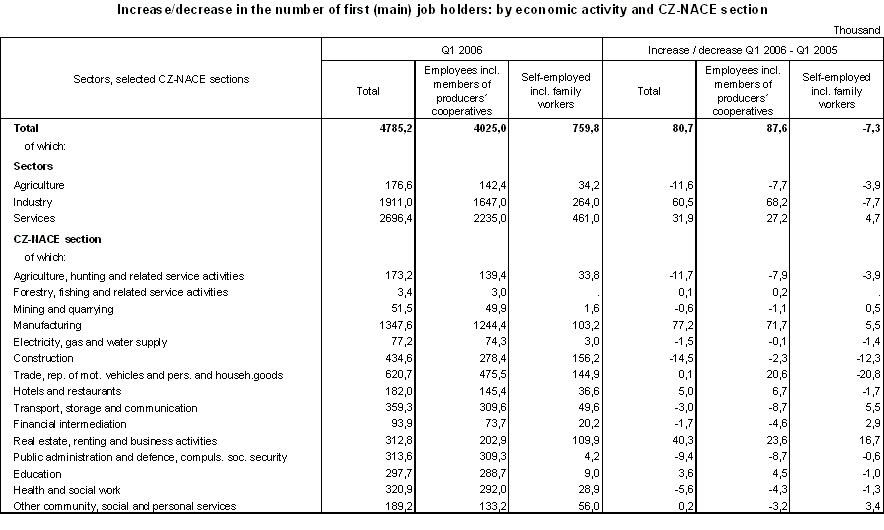
The continuing decrease in the total number of self-employed observed since the beginning of 2005 has been caused in particular by decreasing number of self-employed in ‘trade, repair of motor vehicles, motorcycles and personal and household goods’. Year-on-year decreases in the number of self-employed persons, including contributing family workers, were highest in ‘other retail sale of new goods in specialized stores’ (-9.2 thousand) and in ‘wholesale on a fee or contract basis’ (-7.0 thousand).
The total employment rate of persons aged 15-64 grew year-on-year by 0.7 percentage points to 64.8%. The relative increase was higher in the employment of women at working age (+0.7 percentage points to 56.5%), while employment of men was 0.6 percentage points up and reached 73.0%. The employment rate is pushed down by a fast growth of the number of students at universities on the one hand, and, on the other hand, the number of persons in employment is increasing due to the involvement of strong age groups born at the turn of the forties and fifties and in the middle of seventies.
Compared internationally, the Czech Republic is among the countries with the above-the-average employment intensity in the EU. According to the latest complete data for Q2 2005 released by Eurostat, the employment rate of persons aged 15-64 in the Czech Republic was higher than the total for EU25 and not far from the level in the EU15 (however, we should take account of the fast growth of this indicator in the CR during the whole of the last year). Nevertheless, differences in employment rates are considerable, not only if we compare the whole age group 15-64, but also in the male and female components of employment. On the one hand, there is a high level of employment in the northern countries and the United Kingdom (e.g. in Denmark it was 76.8% in Q4 2005), on the other hand in many countries the level of employment was lower than 60% (in Poland it reached only 53.7%). Compared to our neighbour states, higher level of employment is in Austria and slightly higher also in Germany, level of employment in Poland and also in Slovakia is, however, significantly lower. In the following table, there are apart from data for Q2 also data for Q4 2005 (a qualified estimate was made for some of the countries for Q4 2005).
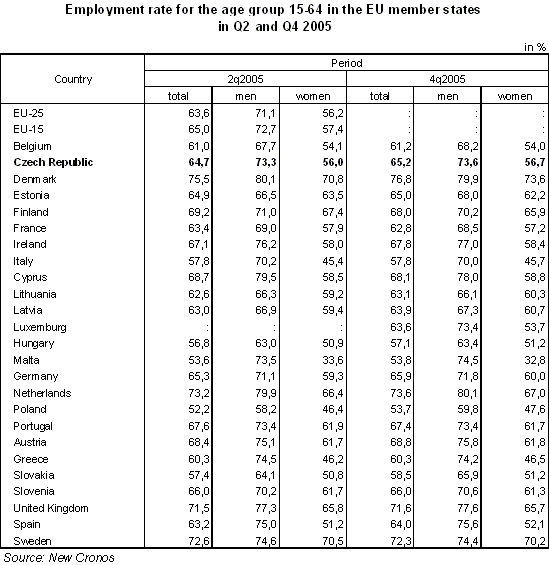
The employment of persons living in the individual regions of the Czech Republic dropped year-on-year only in three of them, most in the Liberecký Region. The number of employed persons increased particularly in the Hl. m. Praha and Středočeský Region.
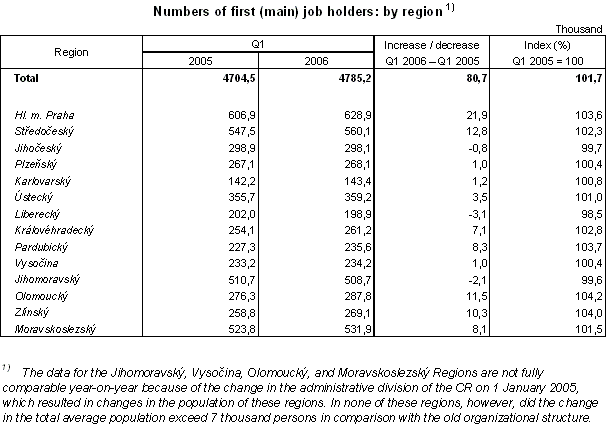
With the growing total employment of the residing population, the number of the economically inactive and the number of the unemployed decreased. The number of unemployed persons (ILO methodology) reached 414.1 thousand on average in Q1 2006, i.e. a fall of 15.0 thousand year-on-year. The number of the unemployed decreased mainly in the age group 20-29 by 24.7 thousand; it also dropped in the age group 35-44 (-4.3 thousand) and in the age group 50-54 (-6.6 thousand). The number of unemployed men (192.4 thousand in total) is still below the number of unemployed women (221.7 thousand). Under the total year-on-year drop in unemployment, the unemployment of men decreased by 19.8 thousand, and the decrease was the biggest in the group of 20-29-year-old persons (-18.9 thousand). Over the same period, the number of unemployed women increased by 4.8 thousand in total, the biggest increase occurred in the age group 15-24 (+5.8 thousand) and in the middle and higher working age group 45-59 (+7.2 thousand).
The number of persons unemployed for a long time (1 year or more) fell by 16.2 thousand. In spite of this total drop, a high increase was recorded among men aged 30-39 (+4.6 thousand).
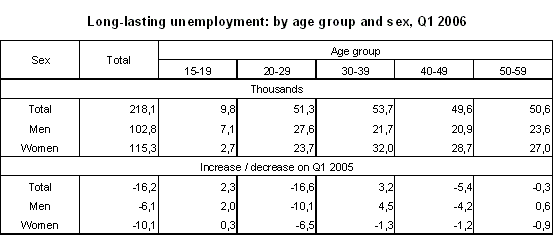
The number of the unemployed with basic education increased by 1.1% year-on-year to 105.1 thousand and that of unemployed persons with secondary education without GCSE (with secondary vocational education in particular) decreased by 10.3% to 193.0 thousand. The number of the unemployed with secondary (with GCSE) increased by 2.5% to 98.4 thousand and the number of unemployed university graduates rose by 25.8% to 17.6 thousand. The unemployment of university graduates is, however, still markedly lower when compared to the first three groups.
Year-on-year, the unemployment dropped particularly in the Olomoucký, Moravskoslezský Regions and the Hl. m. Praha; the situation deteriorated especially in the Jihočeský and Jihomoravský Regions when compared to Q1 of the last year
.
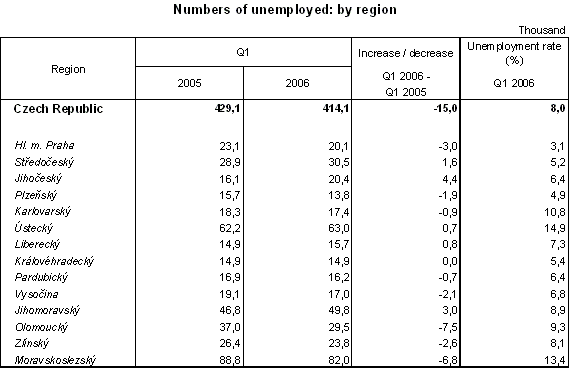
The growth of total employment and the decrease in the number of the unemployed resulted in a relatively high decrease of general unemployment rate (ILO). In comparison to Q1 2005, the general unemployment rate decreased by 0.4 percentage points to 8.0%. It decreased only among the male population (by 0.8 percentage points to 6.6%) while it remained unchanged among the women population (9.7%). The general unemployment rate in the Czech Republic is lower than the average of the whole Community; however, with a relatively favourable level of unemployment level of men the level of unemployment of women in the CR is practically the same as the total for all EU member states.
Compared to the neighbour states the level of unemployment is higher than in Austria but markedly lower than in Poland and Slovakia, where it is still extremely high and the highest throughout the Union. Our unemployment level is lower also in comparison with Germany mainly due to an unfavourable situation in the long run in the federal states in the regions of former DDR.
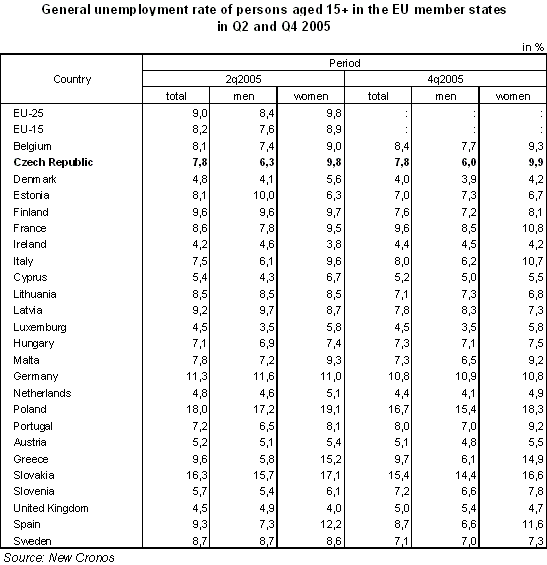
Unlike the total unemployment level the position of the Czech Republic is less favourable from the point of view of long-term unemployment (1 year and more). In Q2 2005, the share of long-term unemployed in the total unemployment was higher only in six countries, of which three are our direct neighbours – Germany, Poland, Slovakia. The share of long-term unemployment in the total unemployment yet again increased in Q4 2005 in the countries with the biggest share of long-term unemployed, i.e. in Poland and Slovakia. This applies both for men and women. Completely different is the situation in Austria, where only one out of four unemployed was unemployed more than one year.
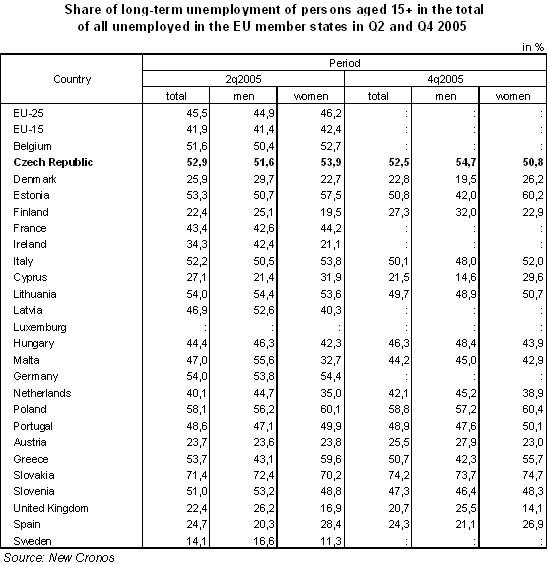
The number of economically inactive persons aged 15+ (according to the LFSS methodology they are persons who had no job and were not seeking a job during last four weeks or did not meet all conditions for being classified among the unemployed) decreased by 3.9 thousand year-on-year and reached 3 554.8 thousand in Q1 2006. This category is primarily affected by numbers of the retired and of persons preparing for their future occupation. The number of basic school pupils increased by 9.5 thousand; the number of secondary school pupils including vocational schools remained approximately on the same level as last year (decrease by 0.5 thousand to 516.9 thousand). The number of university students including higher professional school students grew rapidly by 16.6 thousand to 264.2 thousand. The number of economically inactive normally retired persons not actively seeking job decreased by 0.3 thousand to 1 821.6 thousand and the number of persons in early retirement fell by 9.5 thousand to 62.9 thousand. Furthermore, the number of disability pensioners decreased by 29.3 thousand to 281.6 thousand. These figures cannot accurately correspond to the statistics on pupils and students compiled by the Ministry of Education. Youth and Sports of the CR or to the numbers of pensioners on the records of the Ministry of Labour and Social Affairs of the CR because the pupils, students or pensioners who fulfilled the criterion of being classified among persons in employment or unemployed persons in the reference week are not reported as economically inactive.
